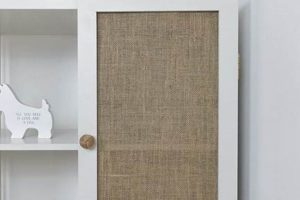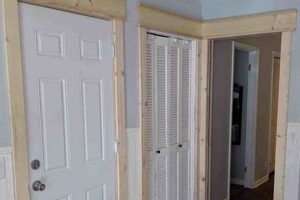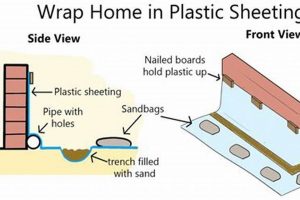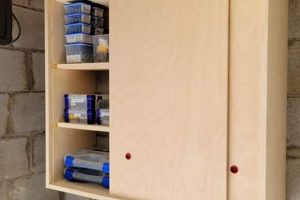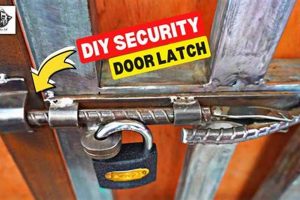Self-installed enclosures for showers represent a cost-effective and customizable alternative to professionally installed systems. These systems typically involve the assembly and fitting of pre-fabricated glass panels, frames, and hardware components within an existing shower space. For example, an individual might purchase a frameless glass panel, hinges, and a handle to create a minimalist shower enclosure, opting for self-installation to reduce labor costs.
Opting for self-installation offers several advantages, including potential cost savings and the satisfaction of completing a home improvement project. Furthermore, it allows for greater control over design choices, enabling homeowners to select materials and styles that precisely match their aesthetic preferences. Historically, the availability of pre-fabricated kits and online resources has significantly contributed to the increasing popularity of this approach to bathroom renovation.
The subsequent sections will delve into the planning stages, necessary tools, installation processes, and potential challenges associated with creating a shower enclosure independently, providing a comprehensive guide for those considering this project.
Essential Guidance for Self-Installing Shower Enclosures
The following recommendations aim to enhance the success and safety of installing shower enclosures independently. Adherence to these guidelines can mitigate potential complications and ensure a professional-quality result.
Tip 1: Meticulous Measurement is Paramount. Accurate dimensions of the shower opening are critical. Measure multiple points and account for any out-of-square conditions. Inaccurate measurements can lead to improperly sized panels and installation difficulties.
Tip 2: Prioritize Safety Glass. Always utilize tempered or laminated safety glass for shower enclosures. These materials are designed to shatter into small, relatively harmless pieces, reducing the risk of serious injury in the event of breakage. Consult with a glass supplier to confirm the glass meets relevant safety standards.
Tip 3: Thoroughly Review Instructions. Carefully examine the manufacturer’s instructions prior to commencing installation. Understand each step and identify all required components. Deviating from the instructions can compromise the structural integrity of the enclosure.
Tip 4: Employ Appropriate Fasteners. Use fasteners designed for the specific wall material (e.g., tile, drywall). Verify the fasteners are of sufficient length and strength to securely support the weight of the glass panels and hardware. Consult with a hardware specialist if unsure.
Tip 5: Apply Silicone Sealant Judiciously. Utilize high-quality, mildew-resistant silicone sealant to create a watertight barrier between the glass panels, frame, and surrounding walls. Apply a consistent bead and smooth it for a professional appearance. Allow adequate curing time before exposing the sealant to moisture.
Tip 6: Ensure Proper Alignment and Leveling. Precise alignment and leveling of the enclosure are essential for smooth operation and preventing leaks. Use a level to verify vertical and horizontal alignment throughout the installation process. Shims can be used to correct minor imperfections in the wall surfaces.
Tip 7: Inspect for Water Leaks. Following installation, thoroughly inspect the enclosure for water leaks. Run the shower and observe the seams, joints, and frame for any signs of water penetration. Address any leaks promptly to prevent water damage.
Careful planning, attention to detail, and adherence to safety protocols are crucial for a successful self-installation of shower enclosures. By following these guidelines, individuals can achieve a functional and aesthetically pleasing bathroom upgrade.
The article will now transition to discussing common issues and troubleshooting tips encountered during the installation process.
1. Measurement Accuracy
Measurement accuracy is fundamentally linked to the successful installation of shower enclosures. Inaccurate measurements directly affect the fit of the glass panels and framing, potentially leading to significant problems during assembly. These problems can range from gaps that allow water leakage to complete incompatibility of the components, rendering the entire self-installation effort futile. A real-world example involves a homeowner who mismeasured the width of the shower opening by a mere quarter of an inch. This seemingly minor error resulted in the custom-ordered glass panel being too large, requiring costly and time-consuming modifications.
The importance of precise measurements extends beyond simply ensuring the panels fit within the shower opening. It also impacts the alignment of the hardware, such as hinges and handles. If the measurements are off, the hardware may not align correctly, resulting in doors that do not close properly or strain the mounting points, potentially leading to premature failure. The practical significance of understanding this connection is clear: investing time in accurate measurements upfront saves considerable expense and frustration down the line. Using precise measuring tools, double-checking all dimensions, and accounting for any out-of-square conditions are vital steps in mitigating these risks.
In summary, measurement accuracy is not merely a preliminary step, but a foundational requirement for DIY shower enclosure projects. Its impact ripples throughout the entire installation process, influencing the final outcome and the long-term performance of the enclosure. Addressing the challenges of obtaining accurate measurements, such as uneven walls or complex shower configurations, requires careful attention to detail and the use of appropriate tools and techniques. Ultimately, prioritizing measurement accuracy is essential for achieving a professional-looking and functional shower enclosure.
2. Material Selection
Material selection exerts a considerable influence on the longevity, safety, and aesthetic appeal of self-installed shower enclosures. The choice of glass, framing materials, and hardware directly impacts the enclosure’s structural integrity, resistance to moisture, and overall visual impression. For example, opting for tempered glass over standard annealed glass is a critical safety consideration, as tempered glass is significantly less likely to shatter into dangerous shards upon impact. Similarly, selecting corrosion-resistant framing materials, such as anodized aluminum or stainless steel, prevents deterioration in the humid shower environment. The practical implication of thoughtful material selection is a reduction in maintenance requirements and an extension of the enclosure’s lifespan.
Furthermore, material choices contribute significantly to the visual style of the shower enclosure. Frameless designs, often employing thick, clear tempered glass and minimalist hardware, create a modern and open aesthetic. Conversely, framed enclosures offer greater flexibility in terms of incorporating decorative glass panels, colored frames, and patterned hardware, allowing for customization to match existing bathroom dcor. An informed decision-making process must balance aesthetic preferences with practical considerations such as cost, ease of installation, and long-term durability. The selection of appropriate sealants and adhesives is also paramount to prevent water leakage and maintain the enclosure’s structural soundness.
In conclusion, material selection is a pivotal aspect of DIY shower enclosure projects. It necessitates a comprehensive understanding of material properties, performance characteristics, and aesthetic attributes. Overlooking this critical element can lead to compromised safety, reduced durability, and diminished visual appeal. Careful consideration of these factors, supported by informed research and consultation with experts, is essential for achieving a successful and satisfying self-installation outcome. This consideration is further complicated by building codes and regulations that mandate specific materials to ensure safety and compliance, which potential installers need to be aware of.
3. Hardware Compatibility
Hardware compatibility is an indispensable component in the successful execution of self-installed shower enclosures. The mechanical connection between the glass panels, the supporting frame, and the surrounding bathroom structure relies entirely on correctly matched hardware components. Incompatibility introduces a cascade of potential problems, ranging from structural instability and operational deficiencies to outright failure of the installation. For instance, using hinges not rated for the weight of the glass panel will inevitably lead to sagging, misalignment, and eventual breakage. This cause-and-effect relationship underscores the importance of meticulous attention to hardware specifications and compatibility charts provided by manufacturers. The practical significance of this understanding lies in preventing premature wear, ensuring user safety, and avoiding costly rework.
Consider a scenario where a homeowner selects aesthetically pleasing handles without verifying their compatibility with the pre-drilled holes in the glass panel. The resulting misalignment not only detracts from the visual appeal but also compromises the integrity of the glass, creating stress points susceptible to fracture. Further, improperly sized or poorly designed mounting brackets can fail to provide adequate support, increasing the risk of the entire enclosure detaching from the wall. A comprehensive approach to hardware selection involves careful consideration of material compatibility, load-bearing capacity, corrosion resistance, and alignment requirements. This often requires consulting technical specifications, verifying dimensions, and seeking expert advice to ensure seamless integration of all components. Pre-packaged DIY shower door kits often simplify this process by including appropriately matched hardware sets, but modifications or component substitutions necessitate rigorous compatibility verification.
In summary, hardware compatibility is not merely a secondary consideration but an essential pre-requisite for safe and functional self-installed shower enclosures. Challenges arise from the vast array of hardware options, differing material properties, and variations in shower enclosure designs. Mitigating these challenges requires diligent research, precise measurements, and a thorough understanding of engineering principles related to load distribution and material stress. By prioritizing hardware compatibility, installers can significantly improve the durability, safety, and long-term performance of their shower enclosures, thereby aligning with the broader goal of achieving professional-quality results through DIY methods.
4. Installation Technique
The proper execution of installation techniques is directly proportional to the success and longevity of self-installed shower enclosures. Deviations from established procedures can compromise structural integrity, water tightness, and overall functionality.
- Plumb and Level Alignment
Accurate vertical and horizontal alignment of the enclosure framework is paramount. Deviations from plumb or level introduce stress points within the structure, potentially leading to glass breakage or premature wear of hardware. Laser levels and shims are essential tools for achieving precise alignment. An example is using shims under the sill to create a perfectly level surface on an uneven bathroom floor, ensuring proper water drainage and preventing leaks.
- Silicone Sealant Application
The consistent and meticulous application of silicone sealant is critical for preventing water infiltration. The sealant must form a continuous, unbroken barrier between the glass, frame, and surrounding wall surfaces. Improper application, such as gaps or insufficient coverage, results in leaks, potentially causing water damage to adjacent structures. For instance, a bead of sealant applied too thinly around the shower door frame will allow water to seep into the wall cavity, promoting mold growth and structural decay.
- Hardware Mounting and Securing
The secure mounting of hinges, handles, and other hardware components is essential for safe and reliable operation. Using fasteners appropriate for the wall material (e.g., tile, drywall) and ensuring proper torque are crucial. Overtightening can crack tiles or strip screw threads, while undertightening results in loose or wobbly hardware. Consider a scenario where inadequate wall anchors are used to support a heavy glass door; the door could eventually detach from the wall, posing a safety hazard.
- Glass Handling and Manipulation
The safe handling of glass panels is of utmost importance during installation. Glass is fragile and susceptible to breakage if mishandled. Using suction cups for lifting and maneuvering large panels is recommended, as is protecting the edges from impacts. Improper handling, such as dragging the glass across abrasive surfaces, can create scratches or weaken the structure, ultimately leading to failure. For example, failing to use suction cups can lead to dropping a glass panel, resulting in shattering and potential injury.
These installation techniques are intrinsically linked to the performance of DIY shower enclosures. Inadequate attention to detail in any of these areas compromises the overall quality and durability of the installation. The effective implementation of these techniques requires a combination of technical skill, appropriate tools, and a thorough understanding of the principles of shower enclosure construction.
5. Sealing Integrity
Sealing integrity is a crucial factor in the performance and longevity of self-installed shower enclosures. Compromised sealing can lead to a range of issues, including water damage, mold growth, and structural deterioration. The following facets explore the key elements contributing to sealing integrity in shower door installations.
- Silicone Sealant Selection
The selection of an appropriate sealant is paramount. Not all silicone sealants are created equal; formulations vary in their resistance to moisture, mildew, and temperature fluctuations. A sealant specifically designed for bathroom applications, often labeled as “mildew-resistant” or “anti-fungal,” is essential. The incorrect selection, such as using a general-purpose sealant, can lead to premature degradation and subsequent water leakage. For example, a non-mildew resistant sealant can become discolored and ineffective within months, necessitating costly resealing.
- Surface Preparation
Proper surface preparation is critical for achieving a strong and durable bond between the sealant and the adjacent surfaces. This includes thoroughly cleaning the surfaces to remove dirt, grease, soap residue, and any existing sealant. The use of a solvent, such as isopropyl alcohol, is recommended to ensure a clean and dry surface. Failure to properly prepare the surface can result in poor adhesion, leading to gaps and water infiltration. For instance, applying sealant over a layer of soap scum will compromise the bond, resulting in leaks even with a high-quality sealant.
- Application Technique
The application technique directly influences the effectiveness of the seal. Applying a consistent bead of sealant, ensuring full contact with both surfaces, is crucial. Overapplication can be messy and wasteful, while underapplication can result in gaps. Tooling the sealant with a specialized tool or a gloved finger immediately after application creates a smooth, concave surface that maximizes contact and prevents water from pooling. An uneven or inconsistent sealant bead is prone to cracking and separation, compromising the water tightness of the enclosure.
- Joint Design and Geometry
The design of the joint where the sealant is applied plays a significant role in sealing integrity. Wide, shallow joints are generally more prone to failure than narrow, deep joints. Designing joints with a consistent gap width and a clean, sharp edge provides a more stable and durable sealing surface. Backer rod can be used in wider joints to control the depth of the sealant and prevent three-sided adhesion, which can lead to cracking. Ignoring joint design considerations can result in a weak and unreliable seal, regardless of the quality of the sealant or the application technique.
The effective implementation of these elements is crucial for maintaining sealing integrity in self-installed shower enclosures. Failure to address these facets can lead to costly repairs and potential structural damage. Thorough planning, meticulous execution, and the use of appropriate materials are essential for achieving a long-lasting and watertight shower enclosure.
6. Safety Protocols
Safety protocols are paramount when undertaking self-installation of shower enclosures, representing a critical safeguard against potential injuries and structural damage. The inherent risks associated with handling heavy glass panels, utilizing power tools in a confined space, and working with plumbing systems necessitate a comprehensive understanding and strict adherence to established safety guidelines. Ignoring these protocols can lead to severe consequences, including lacerations, fractures, electrocution, and water damage.
- Personal Protective Equipment (PPE)
The consistent use of appropriate personal protective equipment is non-negotiable. Safety glasses protect against flying debris during drilling or cutting operations. Heavy-duty work gloves prevent cuts and abrasions from handling glass and sharp tools. Closed-toe shoes provide foot protection against dropped objects. In one instance, a homeowner sustained a severe eye injury due to neglecting to wear safety glasses while drilling through tile, underscoring the critical importance of PPE.
- Glass Handling Techniques
Proper glass handling techniques are essential for minimizing the risk of breakage and injury. Glass panels should be lifted and carried by two people, using suction cups for secure grip and control. Edges should be protected from impact, and the glass should be placed on a padded surface to prevent scratches or cracks. A homeowner who attempted to move a large glass panel alone suffered a deep laceration when the glass slipped and shattered, highlighting the dangers of improper handling.
- Electrical Safety Measures
Electrical safety measures must be strictly observed when working near electrical outlets or plumbing systems. Power to the circuit should be shut off before commencing any work that involves electrical wiring or plumbing connections. Ground Fault Circuit Interrupters (GFCIs) provide additional protection against electrical shock. A contractor inadvertently drilled into an electrical wire while installing a shower enclosure, resulting in a near-fatal electrocution, demonstrating the critical need for electrical safety precautions.
- Structural Integrity Verification
Verifying the structural integrity of the wall framing is crucial before installing the shower enclosure. The walls must be able to support the weight of the glass panels and the hardware. Weak or damaged wall framing should be reinforced before proceeding with the installation. A homeowner installed a heavy frameless shower enclosure on a wall with inadequate framing, leading to the collapse of the wall and extensive water damage, illustrating the importance of structural assessment.
The implementation of these safety protocols is not merely a matter of compliance, but a fundamental responsibility for ensuring the well-being of the installer and the structural integrity of the bathroom. Neglecting these safety measures can have severe and lasting consequences, emphasizing the need for meticulous planning, diligent execution, and a unwavering commitment to safety throughout the entire DIY shower enclosure project. Furthermore, compliance with local building codes and regulations pertaining to safety is paramount.
DIY Shower Doors
The subsequent section addresses commonly encountered queries concerning the self-installation of shower doors. The objective is to provide clarity and guidance based on industry best practices and established safety protocols.
Question 1: What tools are indispensable for installing shower doors independently?
Essential tools encompass a level (preferably laser), measuring tape, drill with appropriate drill bits (including tile bits), stud finder, safety glasses, work gloves, silicone caulk gun, and a utility knife. The specific tools may vary depending on the door type and the wall material. Deviation from this toolset may result in compromised installation quality.
Question 2: How critical is it to use tempered glass for shower door installations?
The utilization of tempered glass is not merely recommended, but mandated by most building codes due to its inherent safety characteristics. Tempered glass shatters into small, relatively harmless fragments, mitigating the risk of severe lacerations in the event of breakage. Standard glass poses a significant safety hazard and is unsuitable for shower door applications.
Question 3: What steps should be taken to ensure a watertight seal around shower doors?
Achieving a watertight seal necessitates meticulous surface preparation, the application of high-quality, mildew-resistant silicone sealant, and proper joint design. Surfaces must be clean, dry, and free of debris. Sealant should be applied in a continuous bead, ensuring full contact with both surfaces. Overlap any seams during this process. Furthermore, allow for adequate curing time (typically 24-48 hours) before exposing the sealant to moisture. Any deviation from this process could cause leakage.
Question 4: What level of expertise is required to install shower doors independently?
While prior experience in home improvement projects is beneficial, successful installation is primarily contingent upon meticulous adherence to instructions, attention to detail, and a comprehensive understanding of basic carpentry principles. Individuals with limited experience should consider seeking guidance from experienced professionals or consulting instructional videos before commencing the project.
Question 5: What common mistakes should be avoided during DIY shower door installation?
Common pitfalls include inaccurate measurements, the use of incompatible hardware, neglecting to address out-of-plumb wall conditions, and inadequate sealing. Addressing these potential errors proactively is crucial for preventing costly rework and ensuring a satisfactory outcome. Double-check all measurements before cutting.
Question 6: How can one ensure compliance with local building codes when installing shower doors?
Compliance with local building codes is paramount for ensuring safety and avoiding potential legal ramifications. Contacting the local building department or consulting with a licensed contractor is recommended to ascertain specific requirements pertaining to shower door installations, including glass type, hardware specifications, and sealing standards. Ignoring these requirements could lead to hefty fines.
This FAQ section underscores the importance of preparation, precision, and adherence to established guidelines for successful DIY shower door installation. While self-installation offers potential cost savings and customization options, prioritizing safety and compliance is non-negotiable.
The subsequent section will address troubleshooting common issues and providing solutions.
Concluding Remarks on Self-Installation of Shower Enclosures
This exposition has elucidated the multifaceted aspects of diy shower doors, underscoring the criticality of accurate measurements, appropriate material selection, hardware compatibility, precise installation techniques, robust sealing integrity, and unwavering adherence to safety protocols. Each element contributes directly to the functional efficacy, structural soundness, and aesthetic quality of the final product. A failure to adequately address any one of these areas can compromise the entire undertaking, resulting in potential safety hazards, costly repairs, and diminished satisfaction.
The decision to pursue self-installation of shower enclosures warrants careful consideration. While the potential for cost savings and customization exists, individuals must possess a requisite level of technical competence and a commitment to meticulous execution. Prioritizing safety, complying with local building codes, and consulting with experienced professionals when necessary are essential for mitigating risks and achieving a successful outcome. The long-term performance and safety of the installed enclosure are directly proportional to the rigor and diligence applied throughout the entire process. Thorough planning is crucial for maximizing the likelihood of a positive result.


